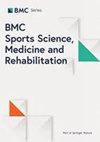参加群众性跑步活动的动机因素:对肢体残疾女性和男性的比较研究
IF 2.1
3区 医学
Q1 REHABILITATION
引用次数: 0
摘要
虽然无障碍人士参加大众跑步活动的动机已得到充分证实,但目前还缺乏对肢体残疾人参加这些活动的原因的研究。本研究旨在确定肢体残疾人参与活动的动机,同时考虑到性别、年龄(新成人与中年人)、受伤或生病后的时间以及跑步时的运动方式(轮椅与站立)等因素。共有 119 名参与者(51.3% 为男性,平均年龄为 36 岁)填写了波兰语版马拉松运动员动机量表问卷。研究采用诊断调查法进行。在线调查表被发送到大波兰地区的 31 个组织,包括残疾人体育俱乐部和同时向残疾人和非残疾人开放的跑步者俱乐部。这项研究根据年龄和跑步时的运动方式发现了明显的动机差异。35 岁以下的参与者与 35 岁以上的参与者相比,在认可动机(Z = - 2.834,p = 0.005)和从属动机(Z = - 2.534,p = 0.011)方面存在显著差异。同样,当比较轮椅使用者和站立者时,我们发现在与体重(Z = - 5.109,p = < 0.001)和个人目标实现(Z = - 2.613,p = 0.009)相关的动机方面存在显著差异。此外,受伤或患病后的时间与马拉松运动员动机量表九个分量表中的五个分量表之间也存在明显的正相关关系(即从属关系:r = 0.256,p = 0.007;认可:r = 0.239,p = 0.011)。研究发现,肢体残疾男性和女性参加大众跑步赛事的动机没有明显差异。在为肢体残疾人组织和推广跑步活动时,必须考虑跑步者的年龄、受伤后的时间以及跑步时的运动方式等因素。此外,需要注意的是,性别差异并不明显,这表明男性和女性参与者参加这些活动的动机相似。本文章由计算机程序翻译,如有差异,请以英文原文为准。
Motivational factors for participation in mass running events: a comparative study of females and males with physical disabilities
While the motivations of individuals without impairments for participating in mass running events are well-documented, there is a lack of current research exploring why people with physical disabilities engage in these events. This study aims to identify the motives for participation among people with physical disabilities, taking into account factors such as sex, age (emerging adults vs. middle-aged adults), time since injury or illness, and mode of movement during the run (wheelchair vs. standing). In total, 119 participants (51.3% male; mean age of 36 years) completed the Polish version of the Motivations of Marathoners Scale questionnaire. The study was carried out using the diagnostic survey method. Online survey forms were sent to 31 organizations from the Greater Poland region, including sports clubs for individuals with disabilities and runners’ clubs open to both individuals with and without disabilities. This study uncovered distinct motivational differences based on age and mode of movement during the run. For participants aged under 35 compared to those over 35, significant differences were noted in the motives of recognition (Z = − 2.834, p = 0.005) and affiliation (Z = − 2.534, p = 0.011). Similarly, when comparing wheelchair users with standing participants, notable disparities were observed in motives related to weight (Z = − 5.109, p = < 0.001) and personal goal achievement (Z = − 2.613, p = 0.009). There was also a significant positive relationship between the time since injury or illness and five out of nine subscales of the Motivations of Marathoners Scale (i.e. affiliation: r = 0.256, p = 0.007; recognition: r = 0.239, p = 0.011). The study found no significant differences in the motivations between men and women with physical disabilities for participating in mass running events. When organizing and promoting running events for people with physical disabilities, it is important to consider factors such as the age of runners, time since injury, and mode of movement during the run. Additionally, it should be noted that no significant differences are found based on gender, indicating that both male and female participants are driven by similar motivations when it comes to participating in these events.
求助全文
通过发布文献求助,成功后即可免费获取论文全文。
去求助
来源期刊

BMC Sports Science Medicine and Rehabilitation
Medicine-Orthopedics and Sports Medicine
CiteScore
3.00
自引率
5.30%
发文量
196
审稿时长
26 weeks
期刊介绍:
BMC Sports Science, Medicine and Rehabilitation is an open access, peer reviewed journal that considers articles on all aspects of sports medicine and the exercise sciences, including rehabilitation, traumatology, cardiology, physiology, and nutrition.
 求助内容:
求助内容: 应助结果提醒方式:
应助结果提醒方式:


